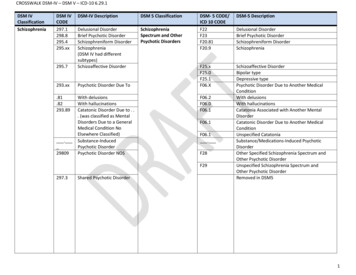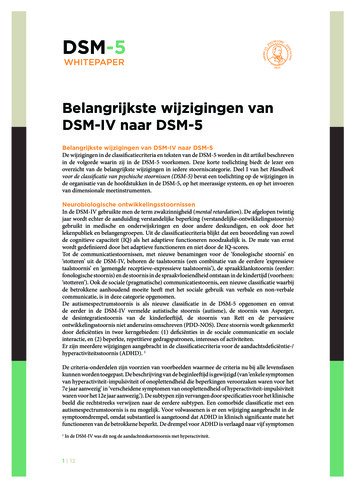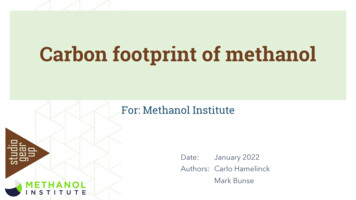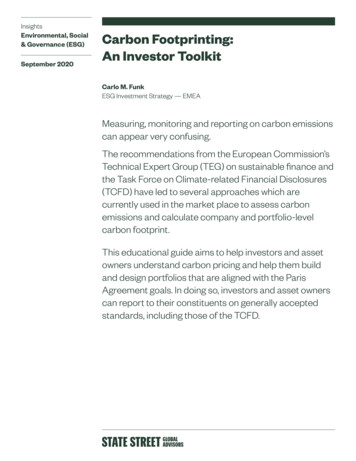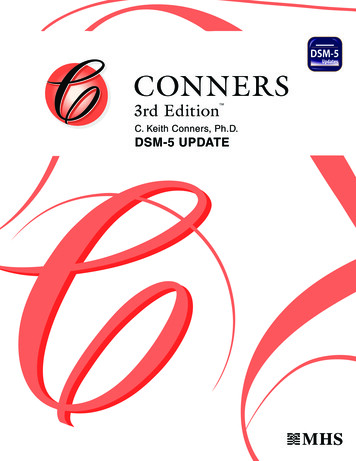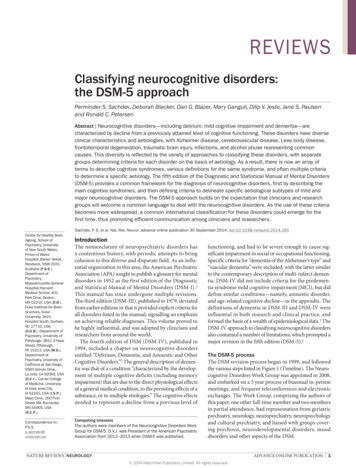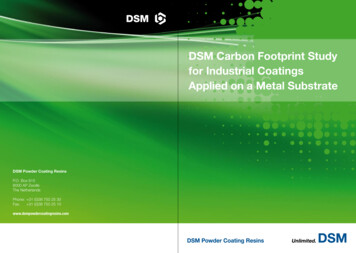
Transcription
DSM Carbon Footprint Studyfor Industrial CoatingsApplied on a Metal SubstrateDSM Powder Coating ResinsP.O. Box 6158000 AP ZwolleThe NetherlandsPhone: 31 (0)38 750 25 30Fax: 31 (0)38 750 25 10www.dsmpowdercoatingresins.com
DSM presents Carbon FootprintStudy for Industrial Coatingsand takes next step towards asustainable Coating Industry.Climate change continues, and worldwide efforts to confront climatechange continue as well. It is one of the biggest challenges facingindustries, governments and society.Policy makers and industry sectors across the world are workingto understand their role and required actions. Individual chemicalcompanies are already pulling their weight in the area of energyefficiency and innovation, recognizing environmental performance– alongside health, safety and security – as essential to businesssuccess.To identify how we can improve the performanceof the coating industry and what impact thechoice of coating system has, we must firstunderstand its current carbon footprint (based onraw materials consumed and energy spent duringmanufacture and application, and transferred toCO2 emissions). DSM has taken the initiative todevelop a common understanding of how thiscan be calculated. Along with related issues andchallenges, individual companies will now be ableto assess themselves in a way that is comparableacross the industry. In the end this will empowerthe whole industry to make the right choices.For many years users have enjoyed the economicand technical benefits of powder coatings. Veryearly, it was intuitively understood that powdercoatings are the coating system with a relativelylow carbon footprint. This was, however, neversupported by a comprehensive analysis takingaccount of all elements involved in the coatingprocess. DSM now has undertaken this step inorder to underpin the prevailing view.In our efforts to reduce the carbon footprint ofour powder coating systems, we want to takethe industry one step further. Our intention isto invest in new systems for new applicationareas including substrates that go beyond thetraditional metal substrates, such as wood andplastics. Working in close partnership with ourcustomers, we aim to help Shaping the PowderCoating Industry as a whole, by providingsustainable solutions for the future.Climate change is not only a challenge, but anopportunity. A paradigm shift to a low-carboneconomy can potentially drive forward a newera of technological innovation. It will require athird - this time green - industrial revolution. Torealize that potential the new framework mustharness the power of the market to deliver ourenvironmental objectives. We trust this study isa first step of a long successful journey towardsa strong, profitable, and sustainable CoatingIndustry.We proudly present our Carbon Footprint Studyfor industrial coatings on metal substrates. Theoutcomes of the carbon footprint calculations forthe various coating systems have been validatedby an independent third party. Outcomes whichconfirm that water borne coatings and powdercoatings produce the lowest carbon footprint.By far the most effective opportunity to furtherreduce the carbon footprint of powder coatingslies in the reduction of layer thickness, followedby epoxy/hybrid replacement and loweringof curing temperatures. DSM is investingsubstantially in all three areas of innovation andwill continue to do so.DSM Powder Coating ResinsDSM Powder Coating Resins
About DSMDSM and its HistoryRoyal DSM N.V. creates solutions that nourish,protect and improve performance. The companycreates products and services in Life Sciencesand Material Sciences.DSM has a long history of transformation.From the beginning in 1902, when the Dutchgovernment formed the state-owned coalcompany, to today’s DSM: a Life Sciences andMaterials Sciences company.Its end markets include human andanimal nutrition and health, personal care,pharmaceuticals, automotive, coatings and paint,electrical and electronics, life protection andhousing.DSM manages its business with a focus on thetriple bottom line of economic performance,environmental quality and social responsibility,which it pursues simultaneously and in parallel. DSM Powder Coating Resins At a very early stage, DSM realized the needfor change. In the 1930s it converted aby-product from coal mining into a profitablecommodity, ammonia, a key raw material fornitrogenous fertilizers. By 1970, chemicals and fertilizers comprisedthe company’s main activity, accounting fortwo-thirds of its turnover. Petrochemicals thentook centre stage. In 1989 DSM was privatized and its shareswere floated on the stock exchange. Over the past 12 years major portfoliochanges have taken place, such as thedivestment of the petrochemicals businessand the acquisition of the vitamins business.With the divestment of the base chemicalsactivities in recent years and the changeswithin the organization, DSM is now ready forthe next growth phase. In this next phase DSM will deliver on itspromise of creating brighter lives for people,driving focused growth, and becoming a trulyglobal company.DSM Powder Coating Resins
DSM’s Mission and SustainabilityOur purpose is to create brighter lives for peopletoday, and for generations to come. This missionis supported by our core value, which is that ouractivities should contribute to a more sustainableworld.By ‘sustainable’ we mean ‘meeting the needsof the present without compromising the abilityof future generations to meet their own needs’.This is the widely accepted definition that theBrundtland Commission published in 1987.Like the Commission, we believe that achievingsustainability means simultaneously pursuingeconomic performance, environmental qualityand social responsibility, in other words, creating DSM Powder Coating ResinsDSM and Climate & Energyvalue on the three dimensions of People, Planetand Profit simultaneously. This is the ‘Triple P’philosophy.We all know that climate change is a reality, andthat energy is a central challenge for society bothin terms of how to create it, and how to get themost out of it. Today the industry as a wholeis seeking sustainable value chains with higheryields, reduced waste, lower energy use, andfewer GHG (Green House Gas) emissions.DSM Powder Coating Resins
DSM’s Focus on PlanetDSM Makes Sustainability part of its StrategyThe Planet element of our sustainability strategyis essentially about caring for the environment.Here is how we work towards greatersustainability in the Planet field:DSM believes that the implications ofsustainability are so profound there is simply nofuture for a modern business which does notembrace a Triple P based approach to doingbusiness. DSM believes sustainability will becomethe key business value driver and differentiatorfor companies worldwide and DSM has a uniqueopportunity to address and capitalize on thisdevelopment.The DSM in motion: driving focused growthstrategy is based on addressing unmet needs inrelation to Global Shifts, Climate and Energy andHealth and Wellness, the major global trends. by performing studies to understand theeco-footprint of our products by developing solutions that reduceeco-footprints throughout the value chainsin which we operate. by continuously improving our own ecofootprint, for example, by using energy andraw materials efficiently and using renewableresources where possible; DSM Powder Coating ResinsTo reach this next level DSM is building on itsinternal value and Triple P driven approach bymaking sustainability a primary business driverfor all its activities. This means embedding TripleP more fully into its organization and activities,tapping the creativity of its increasingly globaland diverse organization and pursuing its Triple Pobjectives in a simultaneous and balanced way.DSM Powder Coating Resins
DSM and LCA StudiesLife Cycle Assessment may be used for variouspurposes. Traditional LCAs target relative scoresfor a range of options to be compared. Theoutcome of such a study, in principle, is that “A isbetter than B within the context of this Study”. Inorder to ensure that such claims carry validity ina general sense, the ISO guidelines prescribe anexpert review if the claim is to be made public.Today it is increasingly common to use so-called“footprint” information in B2B down the valuechain negotiations. Footprints give an absolutescore for a certain product within a standardmethodology framework. One such frameworkis the British PAS2050, a commonly recognized10DSM Powder Coating ResinsDSM aims at Innovative and SustainableCoating Solutionsset of rules for carbon footprint of products,e.g. for use in B2C labelling.Among the many other areas in which DSM isinvolved, DSM is looking to develop sustainablesolutions within the coating industry.DSM has investigated the carbon footprint of theproduction and application of powder coatingsystems in comparison with typical liquid coatingsystems. This report presents the results of itsinvestigations for selected powder, solvent andwater borne coatings.DSM Powder Coating Resins11
LCA Study for Industrial CoatingsThis analysis aims to compare the carbonfootprint of powder coatings with that of commonliquid coatings.The study includes impacts from cradle up tothe application of the coatings onto a 1m2,1mm thick steel substrate.All raw materials used in the production of theresin binders and final coating formulations havebeen taken into account.The application phase analysis includes,where relevant, the energy required to heat thesubstrate, evaporate the solvents, and pre-heat12DSM Powder Coating ResinsLCA Analysis of 11 Industrial Coatingsthe air entering the curing oven to maintain theatmosphere below explosive limits.Incineration of solvents is assumed with theassociated release of CO2 from the combustionof organic materials. This assessment is intendedfor B2B purposes and as such does not includethe full life cycle of the studied products.The study covers the analysis of 11 coatingformulations applied to 1m2 of steelsubstrate. Coatings included:1. Powder coatings for interior and exterior use2. Water borne industrial alkyd coatings and3. Solvent borne polyester and acrylic basedhigh solids coatingsWhile the focus of this report is primarily on thecarbon footprint of each of the examined coatingsystems, other environmental impacts will bepresented in the study to expose the overalleco-footprint.DSM Powder Coating Resins13
Assumptions and Methodology of the StudyNext to all of the above stated assumptions, thefollowing methodology was applied:the carbon footprint was calculated using theIPCC 2007 GWP 100a assessment method andthe results are expressed as kg CO2 equivalents,using the associated characterization factors forthe relevant greenhouse gases.An assessment was made of each coatingsystem using the Eco-indicator 99 method tocheck for unexpected environmental impacts incategories relating to human health, ecosystemquality and resource depletion.14DSM Powder Coating ResinsComponents of this LCA AnalysisThe LCA software SimaPro 7.2.4 has beenused for this study. This software containsthe Eco-Invent v2.2 database which detailsthe environmental profile of a large number ofchemical processes and substances. We haveused the data available from this database wherepossible, and defined our own where necessary.1. The substrate is 1m2 of 1mm thick steel.12. The impacts of the energy required toevaporate solvents and water3. The impacts of the energy required forsubstrate heating4. The impacts of the energy required to heat theprocess air *5. The CO2 emissions from solvent incineration**6. To calculate the quantity of each coatingrequired*** the following parameters weretaken into account:a) Solids contentb) Pigment / binder ratioc) Application thickness of cured, dried coatingd) Transfer efficiency. Specific weight of steel 7800kg/m3, specific heat capacity of steel 438j/kg.oC.5* - *** for more details please refer to a full report that is available upon requestDSM Powder Coating Resins15
The ResultsFor many years users have enjoyed the economicand technical benefits of powder coatings. Earlyon it was already intuitively understood thatamong all coating solutions, powder coatingshave a relatively low carbon footprint.More than One Sustainable Solutioncomprehensive coverage of inputs and outputsof DSM processes. Completeness is estimated at97% and is PAS2050 compliant.There are massive opportunities to reduce CO2emissions by replacing solvent borne coatingswith powder coatings and or water borne paints.This study confirms that water borne and powdercoatings have the lowest carbon footprint whenindustrially applied on a metal substrate.DSM requested CE Delft to assess the conformityof this study with PAS2050 guidelines.CE Delft confirmed that the Carbon FootprintStudy had been performed with care and with16DSM Powder Coating ResinsDSM Powder Coating Resins17
Powder Coatings Can Help Reduce CO2EmissionsReducing Green House Gas Emissions bySwitching Coating SystemsSolvent borne coatings have a higher carbonfootprint than powder coatings as they typicallyrequire more paint to obtain equivalent coverage,and more energy for solvent evaporation and airheating.We can protect the environment by lesseningour CO2 emissions by up to the equivalent of 9.5million cars or average annual carbon footprint of1.5 million people.18DSM Powder Coating ResinsDSM Powder Coating Resins19
DSM’s Innovation efforts in Powder CoatingsBy far the most effective opportunity to reducethe carbon footprint of powder coatings isthe reduction of layer thickness, followed byepoxy/hybrid replacement and lowering of curingtemperatures. DSM is investing substantially inall three areas of innovation and will continue todo so.20DSM Powder Coating ResinsPowder Coatings have Great EnvironmentalBenefitsFor many years users have enjoyed the economicand technical benefits of powder coatings. Veryearly it was intuitively understood that powdercoatings are the coating system with a relativelylow carbon footprint. Until now, this was neversupported by a comprehensive analysis, takinginto account all elements involved in the coatingprocess. With this study DSM has demonstratedthat powder coatings are among the mostsustainable coating solutions.DSM Powder Coating Resins21
Shaping PowderIn our efforts to reduce the eco footprint of ourpowder coating systems, we strive to take theindustry one step further. Our intention is to investin new systems for new application areas andsubstrates that go beyond the traditional metalsubstrates, such as wood and plastic. Workingin close partnership with our customers, ourmission is to help Shaping the Powder CoatingIndustry as a whole, by creating sustainablesolutions for the future.22DSM Powder Coating ResinsTogether We Can Reduce the CarbonFootprint!The philosophy behind this initiative has beento take the powder coating value chain up toa higher level, and to underpin the sustainablecharacter of this technology.To identify ways in which we can improvethe performance of the coating industry andthe impact of the choice of coating system,we must first learn to understand the currentcarbon footprint. Along with related issues andchallenges, other companies will from now onbe able to assess themselves in a way that iscomparable across the industry and that willhelp them make the right choices.A copy of the study is available (at no charge)for all interested parties who wish to join us inShaping the Powder Coating Industry.For more information and a full report please goto www.dsmpowdercoatingresins.com andselect Sustainability page.DSM Powder Coating Resins23
"footprint" information in B2B down the value chain negotiations. Footprints give an absolute score for a certain product within a standard methodology framework. One such framework is the British PAS2050, a commonly recognized set of rules for carbon footprint of products, e.g. for use in B2C labelling. DSM aims at Innovative and Sustainable

